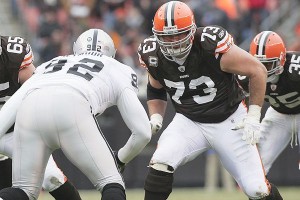Yesterday, I told you about the RSP Writers Project and showed you my roster. As a reminder, here’s the full 53-man team:
QB1 Peyton Manning LDE1 Shea McClellin QB2 Colt McCoy LDE2 Cameron Heyward QB3 Nate Davis DT1 Phil Taylor RB1 Kendall Hunter DT2 Jared Crick RB2 Pierre Thomas DT3 Terrence Cody RB3 LaMichael James DT4 Martin Tevaseu RB4 John Clay RDE1 Vinny Curry WR2 Victor Cruz RDE2 Adam Carriker WR1 Torrey Smith SLB1 Leroy Hill WR3 Anquan Boldin SLB2 Aaron Maybin WR4 T.Y. Hilton MLB1 A.J. Hawk WR5 Ted Ginn Jr. MLB2 Nick Roach WR6 Wallace Wright MLB3 Greg Jones TE1 Jimmy Graham WLB1 Jameel McClain TE2 Delanie Walker WLB2 Clark Haggans TE3 Matthew Mulligan LCB1 Morris Claiborne FB1 Charles Clay LCB2 Kyle Wilson LT1 Jonathan Martin SS1 Eric Berry RT1 Todd Herremans SS2 James Butler LT2 Levy Adcock SS3 James Ihedigbo RT2 Vlad Ducasse FS1 Ryan Clark LG1 Charlie Johnson FS2 Dwight Lowery RG1 Chad Rinehart RCB1 Ike Taylor LG2 Robert T Griffin RCB2 Will D. Allen RG2 Robert Turner C1 Max Unger K1 Ryan Longwell C2 Kris O'Dowd P1 Kevin Huber
But the actual player selections are far less interesting than the reasoning behind the players chosen. You can view the full Q&A session I had with Matt Waldman about my roster, but let me explain two of the philosophies that influenced my roster decisions.
On pass plays, offensive lineman retreat and block; their goal is to prevent the aggressors from reaching the quarterback. When DeMarcus Ware tries to get by David Diehl to get to Eli Manning, Ware is the aggressor and Diehl the defender. In those situations, offensive lineman are essentially gatekeepers, and the key to an effective gate is more about the strength of the weakest link rather than the strength of strongest one. When I built my offensive line, my goal was to avoid having any obvious weakness on which opposing defensive coordinators could focus. If you have $25 million to spend on your offensive line, the smartest move in my opinion is to evenly distribute that money, and that’s exactly what I did. While none of the starters cost more than $5 million per year, none of them cost less than $4.5 million per year, either. Essentially, the whole really is worth more than the sum of its parts.
2) For the same reason, the value of individual defensive players can be overrated
As a Jets fan, I watched Darrelle Revis have a magnificent season in 2009, shutting down practically every wide receiver and helping the other ten members on defense. He was the primary reason the Jets ranked #1 in nearly every major defensive category that season. Then, in the AFC Championship Game, Peyton Manning torched the rest of the Jets defense, as Pierre Garcon and Austin Collie combined for 18 catches for 274 yards and 2 touchdowns. If there’s a weak spot on your defense, an elite quarterback will find it. Even two great corners can be neutralized if you have poor safety play. So in building a defense, my philosophy was less focused on finding stars on defense, and more on avoiding having any weak links. Star players are great, but I think — especially given the constraints of a salary cap — building a capable pass defense is less about finding players to build around and more about avoiding having to field players whom opposing quarterbacks would be eager target.
You can read my full Q&A here.

